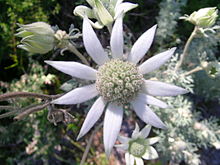Actinotus
Appearance
| Actinotus | |
|---|---|

| |
| Actinotus helianthi | |
| Scientific classification | |
| Kingdom: | Plantae |
| Clade: | Tracheophytes |
| Clade: | Angiosperms |
| Clade: | Eudicots |
| Clade: | Asterids |
| Order: | Apiales |
| Family: | Apiaceae |
| Subfamily: | Mackinlayoideae |
| Genus: | Actinotus Labill. |
| Species | |
|
See text | |
Actinotus is a genus of flowering plants in the family Apiaceae, subfamily Mackinlayoideae, with about 18 species. It is native to Australasia. Its best known member is the flannel flower, a common sight in Sydney bushland in the spring. The generic name, meaning "furnished with rays" is derived from the Greek stem aktin-/ακτιν- "ray" or "sunbeam".[1][2]
Most species are endemic to Australia with one from New Zealand. Other notable species are A. schwarzii from the Macdonnell Ranges in Central Australia, which closely resembles A. helianthi in appearance, and the rare pink-flowering A. forsythii from the Blue Mountains.[2]
Its closest relative is Apiopetalum from New Caledonia.[3]
Species include:[4]
- Actinotus bellidioides (Hook.f.) Benth.
- Actinotus forsythii Maiden & Betche
- Actinotus gibbonsii F.Muell.
- Actinotus glomeratus Benth.
- Actinotus helianthi Labill.
- Actinotus humilis (F.Muell. & Tate) Domin
- Actinotus laxus Keighery
- Actinotus leucocephalus Benth.
- Actinotus minor (Sm.) DC.
- Actinotus moorei F.Muell. ex Rodway
- Actinotus novae-zelandiae (Petrie) Petrie[5]
- Actinotus omnifertilis (F.Muell.) Benth.
- Actinotus paddisonii R.T.Baker
- Actinotus rhomboideus (Turcz.) Benth.
- Actinotus schwarzii F.Muell.
- Actinotus suffocatus (Hook.f.) Rodway
- Actinotus superbus O.H.Sarg.
References
- ^ Liddell & Scott (1980). Greek-English Lexicon, Abridged Edition. Oxford University Press, Oxford, UK. ISBN 0-19-910207-4.
- ^ a b Blombery, Alec (1965). "The genus Actinotus". Australian Plants. 3 (22). ASGAP: 63–65. ISSN 0005-0008.
- ^ Nicolas, A. N., and G. M. Plunkett. (2009) The Demise of Subfamily Hydrocotyloideae (Apiaceae) and the Re-Alignment of Its Genera across the Entire Order Apiales.” Molecular Phylogenetics and Evolution 53 (1): 134–51.
- ^ "Actinotus". Australian Plant Name Index (APNI), IBIS database. Centre for Plant Biodiversity Research, Australian Government, Canberra. Retrieved 2008-09-14.
- ^ "Actinotus Labill. | Plants of the World Online | Kew Science". Plants of the World Online. Retrieved 2020-03-02.
Wikimedia Commons has media related to Actinotus.
